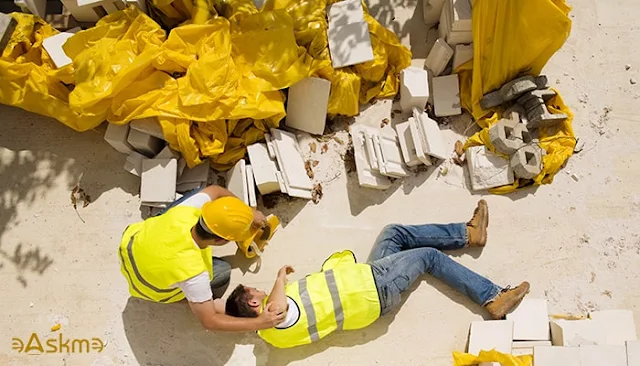Construction sites are inherently hazardous environments, teeming with potential dangers that can lead to accidents and injuries.
As the industry continues to grow, it is crucial for all stakeholders involved, including construction companies, site managers, workers, and regulatory bodies, to maintain a strong focus on safety.
This article will discuss some of the most common accidents that occur in construction sites and explore ways to mitigate these risks.
 |
| What are the Most Common Construction Accidents?: eAskme |
1. High Falls:
It’s no surprise how common ladder fall lawsuits are in the United States.
Falls from height represent one of the most frequent and potentially fatal accidents on construction sites.
Workers can slip or lose balance while working on ladders, scaffolding, roofs, or other elevated platforms.
To reduce the risk of falls, construction companies should:
- Ensure proper training is received on the use of fall protection equipment and safe work practices.
- Use safety equipment such as harnesses, guardrails, and safety nets.
- Regularly inspect work platforms and fall protection equipment for wear or damage.
- Implement virtual reality (VR) and other forms of simulation training programs to enhance workers’ ability to recognize and respond to fall hazards.
2. Falling Objects:
Objects falling from overhead can cause serious injuries or even death to workers on the ground.
This can occur due to improper storage, inadequate securing of materials, or accidents during lifting operations.
To prevent falling object incidents, construction companies should:
- Implement strict guidelines n material storage, handling, and stacking.
- Use appropriate barricades or exclusion zones to protect workers from work areas where objects may fall.
- Ensure that workers wear appropriate personal protective equipment (PPE) like hard hats and steel-toed boots.
- Utilize smart technology, such as sensors and alarms, to alert workers of potential overhead hazards.
3. Vehicle Accidents:
The use of heavy machinery and vehicles, such as forklifts, cranes, and trucks, can lead to accidents when not operated correctly, maintained properly, or when pedestrian workers are present.
To minimize vehicle-related accidents, construction companies should:
- Provide adequate training and certification for vehicle operators.
- Establish rules for vehicle operation, such as designated traffic routes, speed limits, and right-of-way protocols.
- Implement regular inspection and maintenance schedules for all vehicles and equipment. Use technology, such as proximity sensors and collision avoidance systems, to enhance vehicle safety.
4. Electrocution:
Exposed electrical wiring, power lines, and improper use of electrical equipment can lead to electrocution accidents.
To minimize electrocution risks, construction companies should:
- Ensure that all electrical safety systems are properly installed, maintained, and regularly inspected.
- Train workers on electrical safety principles, including the use of appropriate PPE and identification of potential hazards.
- Establish lockout or tagout procedures to prevent accidental energizing of circuits or equipment during maintenance.
- Implement wireless and remote technology to minimize direct contact with electrical hazards.
5. Caught-In or Caught-Between Incidents:
Workers can become trapped or crushed between equipment, materials, or structures.
This can result from heavy equipment malfunctions, collapsing structures, or inadequate safety precautions during work processes.
To prevent caught-in or caught-between incidents, construction companies should:
- Establish safety protocols, such as proper lockout or tagout procedures and machine guarding.
- Train workers on safe work practices, including how to recognize and avoid potential hazards.
- Encourage communication and collaboration between team members to identify and address potential risks.
- Utilize technology, such as cameras and sensors, to monitor blind spots and alert workers to potential hazards.
6. Trenching and Excavation Hazards:
Trench collapses and cave-ins are significant risks in excavation work, often resulting in fatalities.
To avoid these accidents, construction companies should:
- Adhere to OSHA standards for excavation and trenching, including proper sloping, benching, shoring, or shielding techniques.
- Conduct regular inspections of excavation sites by a competent person to identify and address potential hazards.
- Train workers on recognizing unsafe conditions and the appropriate actions to take in case of an emergency.
- Employ ground-penetrating radar and other advanced technologies to detect voids or potential weaknesses in excavation sites.
7. Strain Injuries:
Repetitive motions, awkward postures, and overexertion can lead to injuries, such as strains, sprains, and other muscle injuries.
To minimize these risks, construction companies should:
- Implement solutions, such as adjustable workstations and tools designed to reduce strain.
- Train workers on proper lifting techniques and body mechanics.
- Encourage regular breaks and stretching exercises to promote physical well-being.
- Use exoskeletons and assistive devices to reduce physical strain on workers.
8. Fire and Explosion Risks:
Flammable materials, gas leaks, and improper handling of hazardous substances can lead to fires or explosions on construction sites.
To mitigate these risks, construction companies should:
- Develop and implement fire prevention plans and emergency response procedures.
- Train workers on the proper storage, handling, and disposal of flammable and hazardous materials.
- Regularly inspect and maintain fire extinguishers and other firefighting equipment.Utilize fire detection systems and gas monitors to provide early warning of potential hazards.
Still have any question, do share via comments.
Share this post with your friends and family.
Don't forget to join the eAskme newsletter to stay tuned with us.
Other handpicked guides for you;











